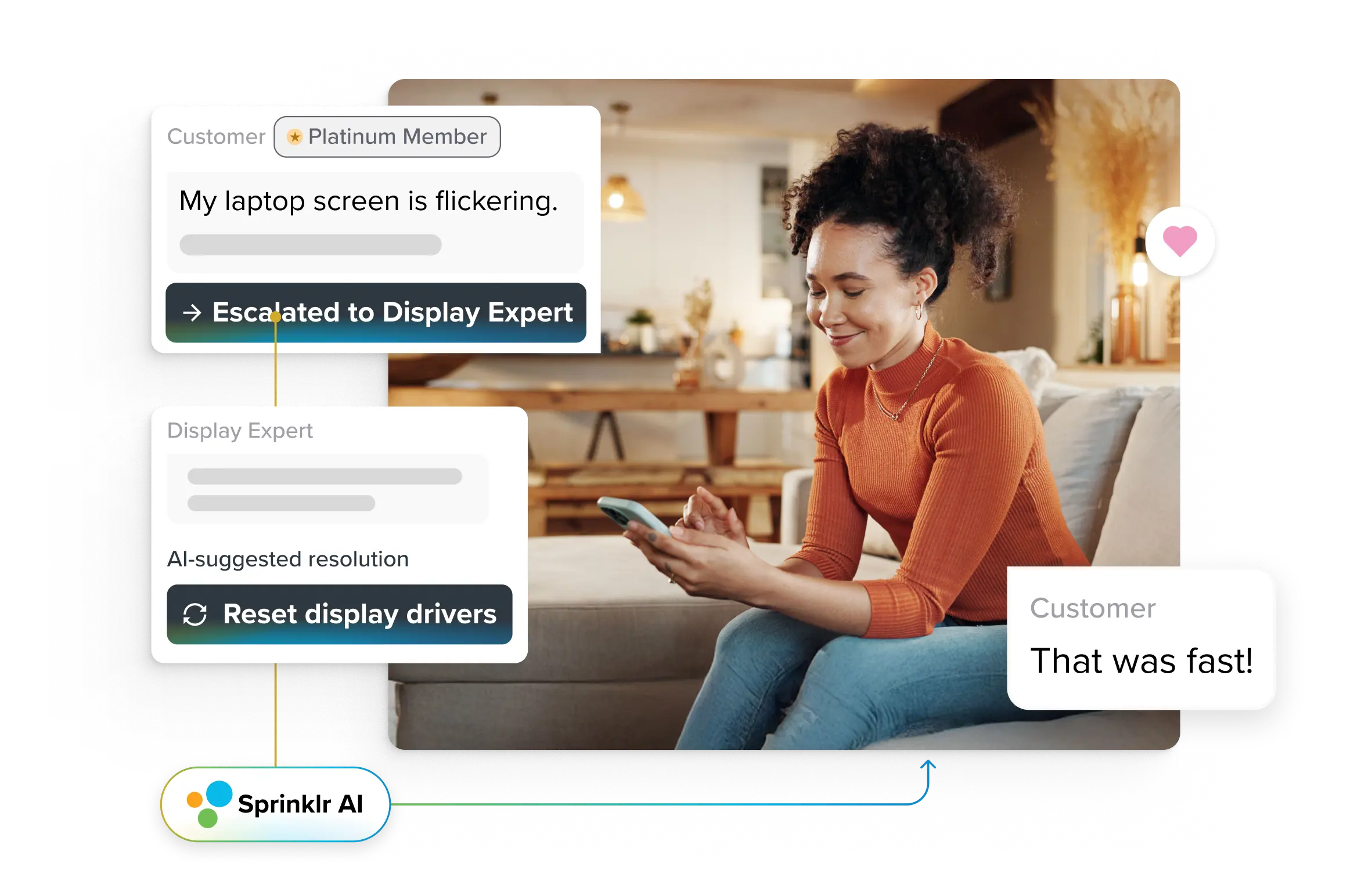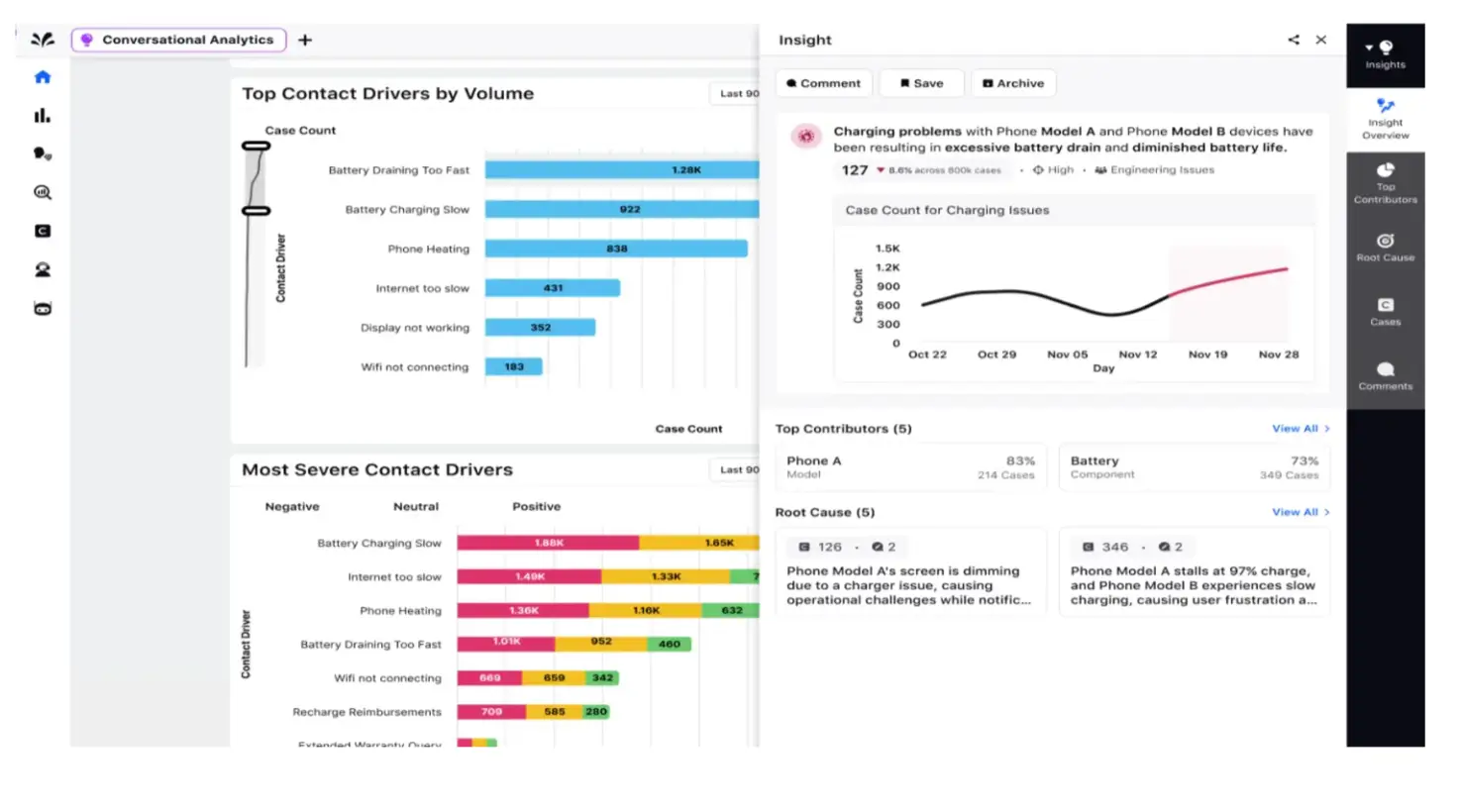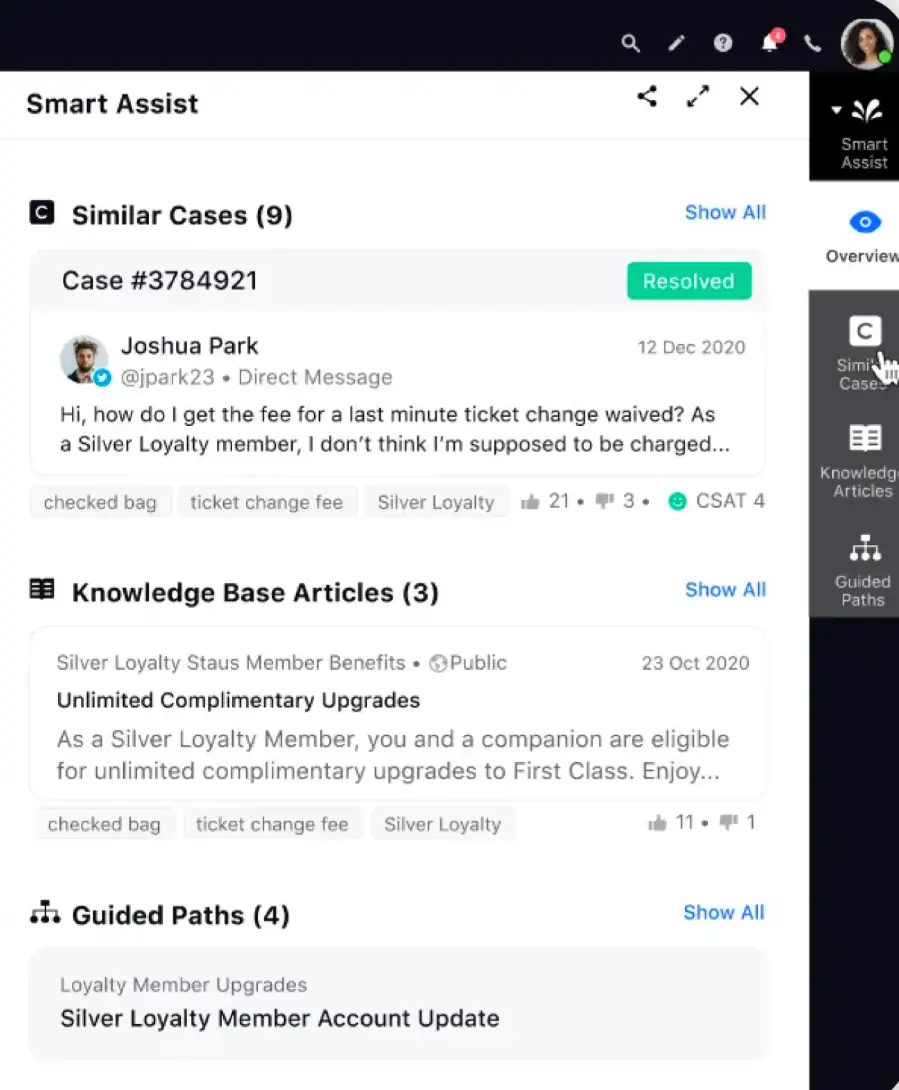Transform CX with AI at the core of every interaction
Unify fragmented interactions across 30+ voice, social and digital channels with an AI-native customer experience platform. Deliver consistent, extraordinary brand experiences at scale.

Omnichannel Customer Experience in the AI Age: How to Implement (+Pro Tips)
In today’s experience economy, what’s the costliest mistake an enterprise can make?
It’s friction.
Whether it’s a global telecom or a buzzy fintech app, customers don’t care who you are. If they hit a snag, trust drops fast.
And in 2025, with AI transforming customer journeys across industries, friction is no longer just inconvenient — it’s inexcusable.
If your brand still makes customers switch channels for answers, repeat their story to every new agent, or wait endlessly for basic updates, you’re behind. Today’s digital-first customers expect seamlessness. And it all begins with delivering a truly omnichannel customer experience.
But let’s set the record straight. Omnichannel isn’t just about being present on every channel. It’s about creating meaningful connections between those touchpoints, where context travels with the customer, agents work from a single view, and AI doesn’t just automate; it enhances every interaction.
And yes, it pays off. Deloitte states that customers who receive high-quality omnichannel experiences are 3.6 times more likely to make additional purchases, driving more cross-sell and upsell opportunities. However, the more significant shift lies in AI-powered orchestration — enabling brands to personalize, predict, and resolve issues at scale.
In this blog, we’ll explore:
- What does omnichannel customer experience mean in the AI era
- The key pillars for success
- The AI technologies powering it
- And how to design an AI-first CX ecosystem that empowers customers, agents, and your bottom line
Let’s dive in.
- What is omnichannel customer experience?
- The evolution of omnichannel experience
- Key pillars of omnichannel CX in the AI era
- Role of AI in enhancing omnichannel customer experience
- How to implement AI-driven omnichannel customer experience
- Challenges in implementing AI-driven omnichannel CX
- Orchestrate or be outpaced
What is omnichannel customer experience?
At its core, omnichannel customer experience is about delivering a consistent, connected, and contextual journey across every customer touchpoint — voice, live chat, email, social media, messaging apps, and more. It ensures customers can move freely between communication channels without repeating themselves, losing context, or feeling like they’re starting over.
In 2025, omnichannel is the default expectation. Channel boundaries have all but disappeared. A customer may start on WhatsApp, continue with a website chatbot, and expect resolution over a call, all without friction. Omnichannel makes that fluidity possible.
In the age of AI, expectations have scaled dramatically. With capabilities like natural language processing (NLP), real-time speech analytics, intent detection, and AI-driven routing, you can anticipate customer needs, surface the right solutions instantly, and equip agents with full context — all from a single, unified interface.
This intersection of digital customer experience and enterprise AI is where competitive advantage takes shape. Enterprises with greater AI maturity gain tighter control over customer journeys, unlock predictive insights, reduce operational complexity, and deliver faster, more human-like customer service at scale.
The evolution of omnichannel experience
In the early 2000s, most brands offered multichannel support, which typically included a call center, an email address, and possibly a website. But these channels worked in silos. Customers had to start from scratch every time they switched channels.
Then came the shift. As smartphones, apps, and social media exploded, so did customer expectations. People wanted faster responses, channel flexibility, and, above all — continuity.
Take the example of a retail banking customer. A decade ago, they might have visited a branch, followed up by phone, and waited days for a resolution. Today, the same customer expects to start a query via mobile app, escalate on chat, and confirm over a quick call — without repeating a single detail.
Now, with AI in the mix, the bar is even higher. It’s no longer just about continuity. It’s about contextual intelligence, knowing why the customer reached out, predicting their next step, and resolving issues proactively. Omnichannel has evolved from presence to personalization and now to prediction, with AI at its core.
Good Read: Predictive Analytics – The Next Big Thing in Customer Service
Key pillars of omnichannel CX in the AI era
Enterprise leaders across conferences and fireside chats are all discussing the same question: “How do we make omnichannel CX real, scalable, and worth the investment?”
Here’s what it takes practically to get it right.
1. Unified customer view
This is non-negotiable. If your teams are toggling between tools, digging through CRM notes, or asking customers to repeat details, you don't have omnichannel; you have channel chaos.
An AI-ready CX stack starts with a single pane of glass. It combines interaction history, preferences, behavioral signals, and customer sentiment across channels into a single, real-time profile. This empowers agents and AI systems to respond with full context.
2. Connected channels with context transfer
Being "present everywhere" isn't enough. Omnichannel only works when context travels with the customer from chatbot to human agent, from WhatsApp to phone. AI makes this seamless by tagging intents, extracting key entities, and preserving emotional cues across customer interactions. That's how you avoid "starting over" syndrome and deliver experiences that feel intelligent and fluid.
3. AI-enabled agent assist
Even the best human agents can't keep up with the complexity of modern customer experience alone. AI needs to work with them — not replace them. Features like real-time summarization, next-best-action suggestions, and emotion detection help contact center agents stay focused, fast, and confident. It's important to understand that more than cost-cutting, it's about amplifying agent performance with precision and care.
4. Automation with human escalation paths
AI-powered customer self-service is powerful, but only when paired with a clear path to human help. Smart automation deflects routine queries, but the moment complexity or emotion enters the equation, a warm handoff to an agent with full context is crucial. This hybrid model is what drives customer loyalty and long-term value.
5. Real-time analytics and closed-loop feedback
Without real-time CX insights, you're flying blind. Leaders need visibility into what's working, what's not, and why — across every channel. AI-enhanced analytics turn interaction data into action: surfacing emerging issues, tracking sentiment trends, and linking CX metrics to business outcomes. And when you combine this with post-interaction feedback loops, your CX strategy becomes self-improving.
Role of AI in enhancing omnichannel customer experience
In theory, delivering a consistent experience across customer service channels sounds achievable. However, in practice, industry insiders are well aware that it’s chaotic. Enterprises are sitting on a sprawl of disconnected systems, fragmented customer data, legacy tech, and siloed teams. Without AI, even the best omnichannel strategies buckle under this weight.
This is where AI becomes the orchestrator. A connecting layer that turns fragmented interactions into fluid journeys.
Turning data chaos into contextual intelligence
Let's take a global airline — managing customer queries across 15+ languages and 8+ channels. A single flight delay can trigger a flood of inquiries, including WhatsApp pings, app chats, calls, social media complaints, and emails to loyalty members.
Without AI, each channel team responds independently, often with conflicting or redundant information, resulting in disjointed CX and overwhelmed agents.
With AI in play, here's what changes:
- NLP models understand and cluster intents across channels — grouping "flight delay," "compensation," and "reschedule" into unified threads.
- Entity recognition identifies specific flights, routes, and customer tiers.
- AI surfaces next-best actions: automatically pushing rescheduled options via the app, initiating proactive outreach for loyalty members, and equipping agents with personalized scripts if escalation is needed.
Suddenly, what was chaos becomes an orchestrated response — fast, relevant, and channel-aware.
😊 Good to know
Platforms like Sprinklr’s conversational analytics software take this even further by analyzing 100% of your conversation data across voice, chat, and messaging channels. You can surface trending topics, decode variations in customer intent and sentiment, and drill down into contact drivers with clear, AI-generated recommendations for resolution. That’s how enterprise teams move from reactive service to data-led CX strategy without guesswork.

Dynamic routing isn’t just smarter — it’s fairer
Most enterprises still rely on rigid IVRs or manual queues. However, AI-powered routing adapts in real-time, not just based on issue type but also sentiment, past behavior, and predicted customer lifetime value.
In a financial services contact center, for instance, AI doesn’t treat all balance-related queries equally. It recognizes the tone of urgency in a customer’s voice, compares it with past churn signals, and routes them directly to a retention-trained team, skipping the generic agent queue altogether. That’s AI-powered customer prioritization driven by intelligence, not guesswork.
Elevating agents beyond scripts
Enterprise agents today aren’t struggling with empathy; they’re struggling with overload. Multiple tools, half-baked insights, and back-and-forth with internal teams drain their time and focus.
AI-powered agent assist software flips this.
In a healthcare CX environment, for example, agents supporting patients with complex insurance queries are guided by real-time co-pilots:
- Summarizing the customer’s past interactions across channels in a single scroll
- Surfacing policy nuances from large internal knowledge bases using retrieval-augmented generation (RAG). Read How Sprinklr Leverages Advanced RAG to Unlock Generative AI for Enterprise Use Cases
- Auto-flagging compliance-sensitive terms during the conversation
This not only speeds things up but also de-risks operations while humanizing service.

From reactive to preemptive CX
The most transformative role AI plays in omnichannel CX is when it moves upstream, predicting problems before they surface.
Take a SaaS company monitoring user behavior across its platform. AI detects a sharp decline in login activity from a high-value customer segment, accompanied by a surge in negative sentiment on community forums. No support tickets have been raised — yet the signals are loud and clear.
Instead of waiting for escalation, AI initiates a preemptive play:
- A personalized email from a dedicated success manager
- A context-aware chatbot nudging users within the app
- Pre-briefed agents equipped with the most likely issue and a recommended resolution script
This is a classic example of proactive customer service driven by customer intelligence, not SLAs.
How to implement AI-driven omnichannel customer experience
Delivering omnichannel CX is a system-level transformation that requires strategic clarity, architectural foresight, and the orchestration of data, models, and people. Here’s a ground-level blueprint that works across enterprise-scale implementations.
1. Start with journey mapping, not channel mapping
Too many projects begin with, “What channels should we support?” The right question is, “What are the moments that matter in our customer journeys?”
Begin by mapping your high-impact journeys, such as customer onboarding, troubleshooting, renewals, and cancellations, and identify points of friction, fragmentation, or repetitive tasks. Then, layer in the channels your customers naturally use during those moments. Keep in mind that the goal is not simply to create a list of touchpoints; rather, it's to develop a journey-driven, cross-channel strategy.
🔖Bookmark Now: Customer Journey Mapping: How to Do it in 5 Steps
2. Centralize customer data with real-time interoperability
Without unified, real-time data, your AI models will be flying blind. Collaborate with your data engineers to develop a customer data fabric that ingests interaction data across various channels into a centralized, real-time ecosystem. Utilize event streaming architecture (e.g., Kafka) to enable low-latency decisions, ensuring clean, labeled, and consented data is readily available to inform NLP models and ML pipelines.
3. Design the right AI layer — not just any AI
Not all AI is equal. You need a CX-focused intelligence layer that’s purpose-built to enhance context, intent, and orchestration.
For conversational channels:
- Use fine-tuned NLP models (LLMs or domain-specific transformers) to detect intent, sentiment, and urgency
- Employ named entity recognition to extract critical fields like account ID, issue type, or product tier
- Integrate RAG (retrieval augmented generation) to pull the latest knowledge base content into chatbot responses
Similarly, for routing and automation:
- Deploy reinforcement learning models that adjust routing based on outcomes (resolution, CSAT score, etc.)
- Use behavioral modeling to predict customer escalation risk or churn probability mid-interaction
4. Invest in an intelligent agent workspace
AI for customers is only half the picture. The other half is equipping agents with tools that make them faster, smarter, and more in control.
Build or deploy a unified agent desktop where AI:
- Auto-summarizes multi-channel interaction history before the agent joins
- Recommends next-best actions based on context and outcome history
- Flag sentiment shifts or compliance red flags during live conversations
5. Establish closed-loop learning and governance
The best AI systems not only act but also learn. Set up feedback loops across channels, where model predictions (e.g., intent, routing decisions, deflection success) are validated by outcomes like CSAT, FCR, and resolution time.
Your data science team should have clear retraining triggers, whether it’s drift detection, seasonal pattern shifts, or customer behavior anomalies. And above all, establish governance. Bias audits, explainability, consent compliance, and security protocols must be baked into every AI workflow — not added later.
Challenges in implementing AI-driven omnichannel CX
AI-driven omnichannel CX sounds transformative in strategy decks. But on the ground, it’s full of operational friction, misaligned expectations, and technical debt — especially in large enterprise environments.
Here’s what the real challenges look like behind the scenes.
- Fragmented tech stack and data silos
Customer data is stored across various systems, including CRMs, ticketing tools, chatbots, cloud telephony systems, and backend order platforms. Each channel team owns its own stack with limited interoperability. AI models often operate on partial, outdated, or unstructured data.
- Lack of a clear AI ownership model
Who owns AI in the contact center? IT, data science, digital CX, or ops? Often, no one has end-to-end accountability, which leads to fragmented pilots, vendor dependency, and unclear success metrics.
- Over-indexing on automation, under-investing in experience
Many teams rush to deploy bots to reduce contact volumes. However, bots often lack context, fail to escalate and frustrate customers. When automation is prioritized over experience, deflection may rise, but CSAT and retention rates drop. Therefore, customer experience leaders need to shift from the mindset of "automate everything" to "automate where it adds value." AI should simplify the experience, not alienate customers.
- Underestimating agent experience complexity
Agents are provided with “AI assist" tools; however, these tools often add to the clutter of legacy desktops and slow systems, requiring constant switching between tabs. As a result, agent burnout increases, and average handling times rise. Instead of enhancing efficiency, your investment in AI becomes a burden on agents. Leaders should prioritize agent experience as an essential part of the customer experience infrastructure rather than treating it as an afterthought.
Orchestrate or be outpaced
Customers don’t care if your chatbot doesn’t integrate with your CRM or if your contact center team can’t see what happened on social media or email. But they do care that they had to repeat themselves. That their issue fell through the cracks. Your competitor resolved the same problem in half the time, with none of the friction.
In 2025, AI without orchestration is noise. Omnichannel without unity is chaos.
This is where the need of the hour becomes clear:
You don’t just need more channels or more bots; you need a Unified CXM approach. One that centralizes data, connects every channel, empowers agents, and activates AI across every interaction point in real-time, at scale.
Sprinklr’s Unified-CXM platform is built for this exact reality. It brings voice, digital, social, chat, messaging, and AI into one operating system — with the intelligence to automate, the flexibility to adapt, and the control to scale with enterprise needs.
Because when every customer interaction is connected, intelligent, and actionable, you don’t just keep up. You lead.
Take the first step. Book a quick demo today.
Frequently Asked Questions
AI connects data across channels, predicts customer intent and delivers personalized interactions in real time. It helps in making experiences faster, smarter and more relevant.
Look at customer satisfaction (CSAT), Net Promoter Score (NPS), resolution time, personalization accuracy and cross-channel engagement rates. Beyond these, you can monitor how AI implementation impacts agent efficiency and the overall cost of customer service operations.
Adopt strict data governance, ensure model transparency, comply with regional regulations (like GDPR) and choose vendors with robust privacy controls. Regular audits and assessments of data security measures should be conducted to identify and address potential vulnerabilities.
Retail, telecom and financial services are ahead, driven by high customer interaction volume and the need for seamless, real-time engagement. Generally, customer-facing industries benefit significantly from AI-powered omnichannel strategies.
Start with a unified data strategy, integrate scalable AI tools, enable cross-functional teams and phase rollout through pilots. Also, remember to iterate and optimize your strategy continuously based on feedback and other responses from your CX infrastructure.










